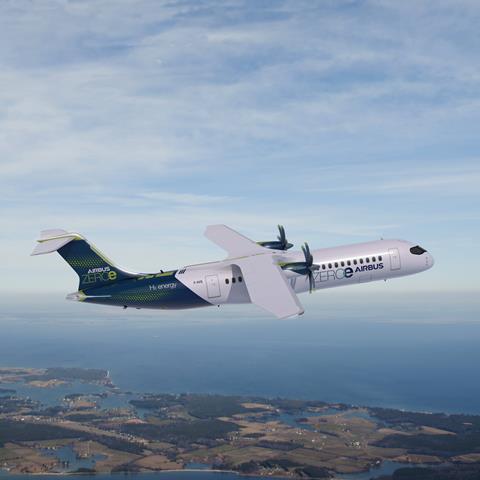Airbus has partnered with several North American airports and US carrier Delta Air Lines to study the feasibility of equipping airports with infrastructure needed to support distribution of hydrogen fuel for aircraft.
The Toulouse manufacturer on 21 May revealed plans to launch several such studies, saying the results will more broadly help it determine the feasibility of developing a hydrogen-powered passenger aircraft under its ZEROe programme.
Under that effort, Airbus aims to have such an aircraft ready by 2035.
“We are launching hydrogen infrastructure studies with many partners… in order to understand what are the conditions of readiness for this hydrogen ecosystem,” says Airbus vice-president of the ZEROe ecosystem Karine Guenan. The studies will help “ensure our ambition to bring to market a hydrogen commercial aircraft… in 2035”.

The evaluations will involve “three groundbreaking studies focused on developing hydrogen hubs at major airports across North America”, says Airbus. The studies, to be completed in 12-18 months, will help define requirements for an “end to-end” hydrogen supply chain and help determine if and how airports could accommodate hydrogen fuel.
Three airports in Canada – Montreal-Trudeau International, Toronto Pearson International and Vancouver International – have signed memorandum of understandings with Airbus and UK-based hydrogen-electric propulsion system developer ZeroAvia to “study the feasibility of… hydrogen infrastructure at airports in Canada”, Airbus says.
ZeroAvia, which last year secured funding from investors including Airbus, is developing hydrogen fuel cell power trains and has been assisting with hydrogen-power modifications of a Dornier 228 and a De Havilland Canada Dash 8-400.
Airbus is also launching such studies in the USA. It joined with Atlanta’s Hartsfield-Jackson International airport, Delta (which maintains a hub in Atlanta) and New York fuel-cell developer Plug Power to study “the challenges of developing a hydrogen hub at airports” and the “possibility” of making Atlanta such a hub.
With similar goals, Airbus has formed a partnership with Houston Airport System and regional advocacy nonprofit Center for Houston’s Future.
“We strongly believe in hydrogen as one of the key levers” in helping the aerospace industry reduce carbon emissions, says Guenan. Other means include increased use of so-called sustainable aviation fuel (which remains prohibitively expensive and in incredibly short supply), replacement of older aircraft with new, more-efficient models, and “incremental improvement” of existing aircraft, she adds.
The studies will also help the company understand the likely availability and cost of hydrogen.
Airbus has formed several other hydrogen-fuel-focused partnerships outside North American, including in France, Germany, Italy, Japan, New Zealand, Norway, Singapore, South Korea and Sweden.
Airbus and others have touted hydrogen as holding incredible opportunity to reduce the aerospace industry’s carbon output. When burned as fuel, or when used to create electricity, hydrogen emits only water.
The concept is far from new. It also poses significant challenges that make the feasibility of widespread adoption uncertain.
Chief among those is that liquid hydrogen has four times the volume by energy unit than fossil-based jet fuel, meaning a hydrogen-powered aircraft would need to carry far more fuel for the same range – a factor that may require the designs of hydrogen-powered aircraft to be significantly different from today’s designs. Gaseous hydrogen has a less energy density further still, meaning an even greater volume of fuel would be required in that form.
Another challenge: hydrogen must be stored at a frigid -253°C (-423°F) to remain in the more-useful liquid form.
Airbus in 2020 revealed three hydrogen-powered aircraft concepts as part of its ZEROe programme.
Those concepts included a 200-passenger, 2,000nm (3,704km)-range blended-wing-body aircraft, a conventional-looking 200-passenger, 2,000nm-range narrowbody aircraft, and a 100-passenger, 1,000nm-range turboprop.
In February, Airbus chief executive Guillaume Faury suggested the company’s first hydrogen-powered aircraft will be relatively small, saying it will fit the “low end of the market” and not compete with Airbus’s existing products.


























